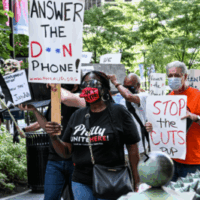The devastation caused by the recent hurricanes, fires and now the Coronavirus, provides a stark reminder of how vulnerable our communities are to natural and man-made disasters and pandemics, and the absolutely vital role that unemployment benefits play in providing economic security to shore up workers, families, and businesses. In times of severe economic downturns and unemployment, which are all too often caused by major disasters, working families rely on state unemployment insurance (UI) and a federal program called Disaster Unemployment Assistance (DUA) to get back on their feet while they rebuild their communities.
What is Disaster Unemployment Assistance (DUA)?
DUA is a program of financial assistance available to workers (including the self-employed) in those counties declared as disaster areas by the president if they are continuously unemployed as a direct result of a disaster.
- Unemployed workers may not receive DUA if they qualify for state UI benefits.
- DUA benefits can last up to a maximum of 26 weeks (unless they are extended by Congress).
- The minimum DUA benefit is set at half the average UI benefit provided by the state. Nationally, the average UI benefit in 2019 was about $380 per week, so the minimum DUA benefit averages about $190 per week.
- Federal rules require workers to file for DUA within 30 days from when the availability of DUA is announced by the state (unless the workers have “good cause” for filing late), and they must provide information substantiating their earnings and employment history within 21 days after filing for benefits.
Key DUA Reforms
After cost-cutting reforms to the DUA program adopted in 1988, the program was restricted to those workers who do not qualify for regular state jobless benefits, mostly including the self-employed and those who have exhausted regular state UI benefits. By shifting the responsibility from federal FEMA funding to the individual state UI programs, jobless families are often left with extremely limited support when they need the help most. At the same time, employers and the disaster states are left paying the extra costs of the program when they can least afford to do so.
Congress should reform the DUA program as follows:
- Remove the federal restriction requiring unemployed families from disaster areas who qualify to collect limited state unemployment benefits rather than federally-funded DUA.
- Establish a minimum DUA benefit that is 1.5 times the national average state UI benefit (or $531), thus eliminating the extreme arbitrariness resulting from the current law — where DUA benefit levels are determined by the states — and mitigating the economic hardship imposed on workers in Florida and other states that pay especially low benefits relative to the average state wages.
- Extend the maximum period of DUA benefits from 26 weeks under the current law to 52 weeks to account for the especially severe economic hardship caused by today’s disasters.
- Increase the state administrative funding to cover all the costs incurred in processing DUA benefits during major disasters.
U.S. Department of Labor (DOL) should reform the DUA program as follows:
- Consistent with the authority provided under federal law, DOL should significantly increase the minimum DUA benefit in the states above the current minimum amount (which is set at 50 percent of the average state UI benefit).
- DOL should remove the unfair offsets against DUA benefits for other sources of income, which far exceed the offsets required under most state laws.
- DOL should cover more workers employed outside the disaster area who were laid off by employers who lost significant revenue as a result of the disaster event.
- As it has done in response to prior disasters, DOL should extend the 30-day deadline required to apply for DUA benefits and the 21-day deadline required to produce wage and work history information.
Key state UI reforms:
The states and U.S. territories impacted are in position to take several immediate steps to shore-up their UI programs to be more responsive in the face of major disasters and the Coronavirus:
- Suspend the “Waiting Week”:Many states have in place a “waiting week” requirement that prevents qualified workers from receiving their weekly benefits during their first week of unemployment. They should suspend the “waiting week” requirement to support workers who find themselves unemployed or separated from work temporarily as a result of a disaster or the Coronavirus.
- Relax the “Work Search” Requirement: Many states impose strict mandates requiring workers to actively seek new work. Given the difficult realities and limitations facing those seeking work in a disaster area or separated from work because of the Coronavirus, the states should significantly relax or suspend their work-search mandates.
- Increase UI Benefit Levels: Workers and families suffering from unemployment or a temporary separation from work resulting from a disaster or the Coronavirus face living expenses that will often far exceed the amount they are eligible to collect in UI. Thus, the states should take steps to boost their UI benefits for people collecting benefits.
- “Non-Charge” UI Benefits: Because workers who are unemployed or temporarily separated from work due to a disaster or the Coronavirus are required to file for any state UI benefits for which they may be eligible, employers usually bear the increased costs associated with the resulting spike in benefits. States have the authority to “non-charge” benefits paid in these cases, which means that the benefit charges are pooled by all employers contributing to the unemployment trust fund.
Related to
Related Resources
All resourcesCase Study: How Virginia Worker Advocates Advanced Unemployment Insurance Reform in a Divided State Government

Policy & Data Brief
Letter on Making Reforms to Virginia’s Unemployment Insurance System

Comments & Letters
Letter on Rescinding Funds for Improving Unemployment Insurance Systems

Comments & Letters
